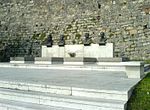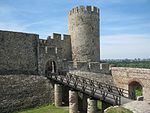Siege of Belgrade (1717)

The siege of Belgrade was a successful attempt by Austrian troops under the command of Prince Eugene of Savoy to capture the strategically important city of Belgrade from the Ottoman Empire. It took place during the Seventh Ottoman–Venetian War (1714–1718), barely a year after the Austrian victory at the Battle of Petrovaradin (Peterwardein). The Austrians routed the Ottoman relief army under Grand Vizier Hacı Halil Pasha on 16 August. As a consequence, the Belgrade garrison, deprived of relief, surrendered to the Austrians on 21 August. The Ottoman Sultan Ahmed III sued for peace, resulting in the Treaty of Passarowitz a year later, which completed the transfer of the remainder of Hungary, the Banat and the city of Belgrade into Austrian hands.
Excerpt from the Wikipedia article Siege of Belgrade (1717) (License: CC BY-SA 3.0, Authors, Images).Siege of Belgrade (1717)
Велико силазно степениште, Belgrade Old Town (Stari Grad Urban Municipality)
Geographical coordinates (GPS) Address Website Nearby Places Show on map
Geographical coordinates (GPS)
| Latitude | Longitude |
|---|---|
| N 44.823333333333 ° | E 20.450277777778 ° |
Address
Београдска тврђава
Велико силазно степениште
11000 Belgrade, Old Town (Stari Grad Urban Municipality)
Central Serbia, Serbia
Open on Google Maps











